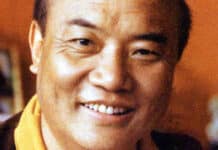
This article was written in February 1998 in response to the following post from Emily Danies: 1) Please would somebody define “mamo” so I can explain it to other practitioners. 2) What is the home practice for mamo chants during this last week before Shambhala Day? ( there’s no “center” wherein one can practice).
—Thanks Emily Danies, 2/21/1998
Mamos
“Mamos” refers to a wrathful “feminine” force, which is sometimes protective, but frequently destructive. The dharmapalas, especially the feminine wisdom dharmapalas, like Vetali and Ekajati, have hosts of mamos in their retinue. The circumstances vividly described in the Mamo chant, such as “family feuds and civil wars” are seen as both the cause and effect of stirring up the “mamo’s wrath.” The significance is as follows.
Basic Feminine Principle
In the tantric view, the basic energies in the universe are basically good, or ‘pure’ in the sense of being unbiased, that is without the territories of ego. In the progressively confused realms of existence (like ours), both the self and experiences get solidified, and energy gets filtered and channeled through the central territory of the ‘self’ and its agendas. Thus in tantric terms, the basic feminine force is complete openness and accomodation, panoramic appreciative awareness, and universal passion-compassion, without partiality. In our somewhat veiled state it is devotion, love, affection, passion, nurturing, social connectedness — more or less sane or neurotic. So at our level, “passion”, or the feminine principle, functions as a force of creating harmony, friendship, and connectedness, in relationships and family, in community, between self and nature, and between mind and body. When the basic energy gets twisted further through the ego’s centralization, it can become hunger, paranoid and jealous desire, manipulative, exploitative, or hypnotic energy, predatory seduction and betrayal, and so on.
Similarly we could connect the basic “masculine force” with immoveability, skillful means, power or strength; in our world with a sense of purpose and protection; and negatively with aggression, empirebuilding, and powertripping of whatever kind.
Existence as a Charnel Ground
From the practitioner’s point of view we might appreciate the whole spectrum of manifestation of these energies — we have seeds of manifesting them in ourselves, and certainly they manifest in the world. Thus the Vidyadhara used to talk about the experience of life as the “charnel ground” — by which he meant seeing the raw quality of the energies as they are. Without idealizing or demonizing things, both extremes seem to be present in our world.
Riding our Energy, the Yidams
“Practice” in our sense involves riding the energy of one’s life. In the practice of vajrayana, the role of the yidams or “meditational wisdom archetypes” like Vajrayogini and the others, is to help us ride, tame, and even transmute the confused energies within and around us. First we have to relate with our own emotions and confusions openly; this is what gives us the language to relate with the dharmapalas. By relating with Wisdom Mother Vajrayogini in our own being, for instance, we gradually also begin to see Mahakali Vetali.
Riding the Energy of Life, the Wisdom Dharmapalas
Further than that, the role of the dharma protectors is first, to protect the integrity of the teaching itself, and second, to help tame and transmute confused energies in the environment. The dharmapalas are actual forces, part of the activity of enlightened lineage, who embody the activity of transmutation. Thus the actual ‘point of view’ of the wisdom dharmapalas is very advanced: it is the view that within the all-victorious purity of the basic nature, everything can be transmuted, and every negativity can be overcome. Openness can open itself and destructiveness can destroy itself.
As Milarepa proclaimed when he remained immoveable in his realization, even under the force of the goddess Tseringma’s attack, “Today I have witnessed that all demons and negative forces have become Guardians of the Dharma.”
The wisdom dharmapalas therefore have a dual personality, so to speak: while coming from the completely pure wisdom mind, they function in the confused world. They are right at home in the charnel ground — to them, the charnel ground is the completely pure dharmadhatu. Because they live in the charnel ground, where we also live, they are close to the yogini and yogin, and can help us. Outwardly, they might help pacify illness and emotionality, enrich situations, magnetize helpful connections, and overcome negative external and psychic conditions. Inwardly, they may help purify and transmute emotions and clinging, and assist in sychronizing body and mind; secretly they may help the practitioners deepen their realization. Still, to make a relationship with Pernachen or Four Armed Mahakala or Mahakali Vetali might be a little challenging: they embody the understanding of transmutation, so if we do not ride our own awareness or energy properly, we might get hit or led astray by our own heightened neurosis. It is a natural consequence; cause and effect is more immediate.
The Action Dharmapalas
The wisdom dharmapalas, as a natural process, have their emanation energies or more worldly minions, called the action dharmapalas. Because of the ambivalent, or dual character of the dharmapalas, sometimes these forces function to pacify our body and mind, create harmony in community and society; and sometimes these forces create chaos and obstacles. It depends of the discipline, sanity, and integrity of one’s community.
Therefore it seems that the teaching on the dharmapalas is neither about just a kind of protective force that would always be nice to us, and be on our side, nor about a way to curse our enemies. Rather, the teaching on the dharmapalas has come down to us from great masters with a very unbiased view of the energies of the world, completely beyond wishful thinking and personal agendas.
Is Vetali a “Real Entity”?
Well, are these forces “real”, and are they like “persons”, and do they come from Tibet (or India)? Let’s take Mahakali Vetali as an example (if she permits). The Vidyadhara suggested that we visualize Vetali in the context of the chant “Pacifying the Turmoil of the Mamos”, because, he said “she is the Queen of the Mamos” in the sense of having sovereignty over them.
Her practice was brought into Tibet by Padmasambhava, and also by Marpa, who received her as a protectress from Naropa. How do great siddhas like these perceive activity and basic protection from the vajra nature as peaceful-wrathful feminine force, as creative-destructive passion?
Perhaps at our level of development we might say that Mahakali Vetali is a symbolic teaching that suggests how to relate with feminine energy in its complete spectrum of manifestations, and how to invoke the help of the lineage in transmuting and pacifying obstacles. On the one hand, “she” — or rather her many emanations — are very close to us. On the other hand Vetali-Rangjung Gyelmo is a cosmic principle, she is an activity manifestation of enlightened lineage. By suggesting this is “symbolic teaching” I don’t mean it is not real. On the contrary, what “Vetali” actually refers to, may be much more real and pervasive than our projections of some little protective deity we have with us. Perhaps to say that she is an “entity” limits too much the scope of what Vetali “means.” “Entity” is the language of solidified ego-projection, and no doubt such ego-projection does not see a force like this as it truly is.
Getting Back to the Mamos
Perhaps we are just talking about the natural energy ecology of the universe. If we engage in basically wholesome and constructive activity, and our minds are genuine and straitforward, and our community and society is likewise, this invokes and attracts a natural blessing into our activity, what we call “drala” or “good energy” or the “Way of Beauty” or a hundred other names. Then again if we engage in negative, aggressive, perverted behavior, this spreads its own contagion in the world and invites more of the same negative energy. This is what the “turmoil of the mamos” refers to. Turmoil of the mamos, being connected with the feminine force, is more especially connected with breakdown of people’s connectedness, their social fabric, dysfunctional families, betrayal of loyalties — “perversion of passion” in that sense. It also refers to illness and disease, the body-mind energies being distorted and out of balance. A protector’s practice is traditionally done at the close of the year to help clear away accumulated negativites. That is why we do the practice to Pacify the Turmoil of the Mamos at this time.
© Dorje Loppon Lodro Dorje (Holm), February 24, 1998, Originally posted on the Chronicles February 15,2010

















